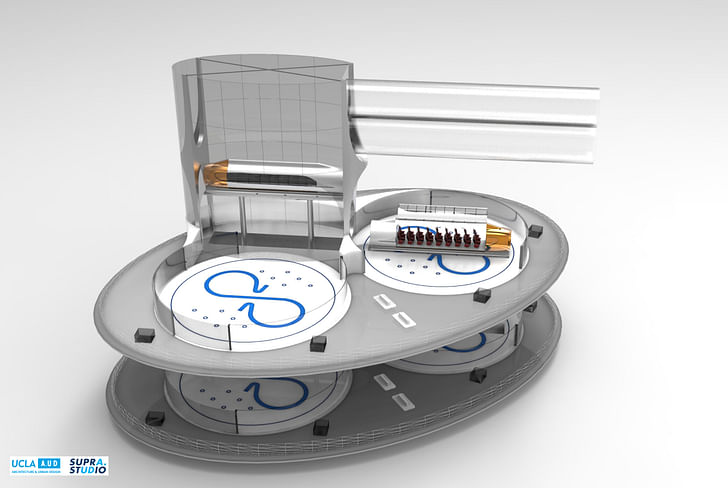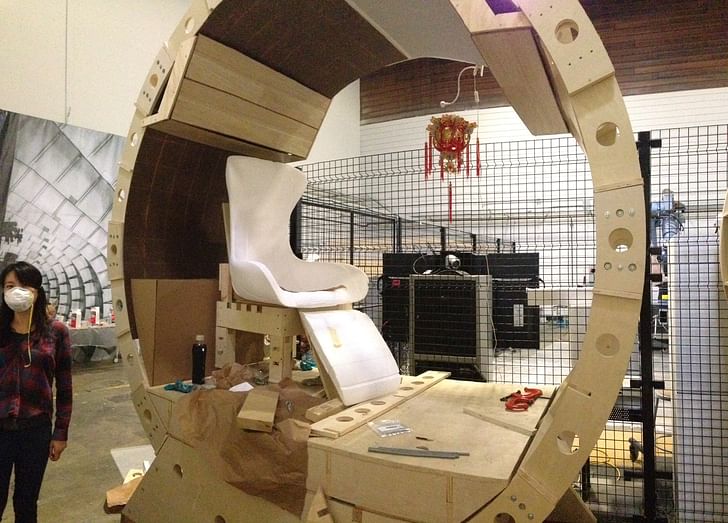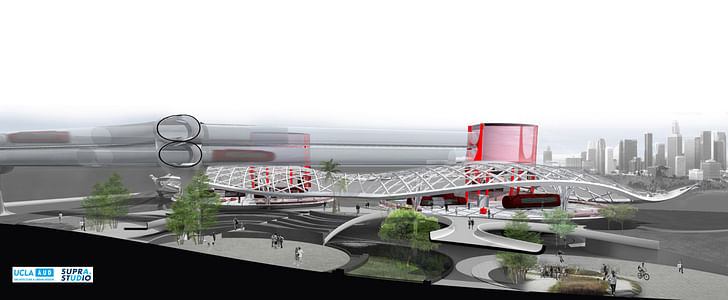

Walking into the enormous Hercules building on UCLA’s IDEAS campus, in the tech-infused suburb of Playa Vista, feels a bit like a traveling through a rip in space-time. The Hercules building is a giant airplane hangar – now, it’s neighbor to YouTube’s offices and a twin hangar where film studios stage scenes for steroidal Hollywood blockbusters like Transformers and Avatar, and formerly, it housed Howard Hughes’ Spruce Goose. And since last fall, the hangar has played host to another audacious promise of transportation technology: the Hyperloop.
Twenty-five students in UCLA’s MArch II program are working with Craig Hodgetts to design the Hyperloop’s physical reality – what it will look and feel like to travel at roughly 760 mph between Los Angeles and San Francisco. It should first be made clear that Hodgett’s studio, the Cypertopia Suprastudio, is taking the technological aspects for granted – whatever engineering grey areas may still persist in the idea of the Hyperloop, the studio is committed to the idea becoming a reality soon enough. This frees them up to focus on everything else: what the Hyperloop capsule will look like, how passengers will board and unboard, the station designs, and the precise route through California’s central valley. While Elon Musk, who dropped the initial Hyperloop proposal in August 2013, has made clear he isn’t going to spearhead the project himself, he has retained a peripheral (for Musk) role. In January, he announced on Twitter that he’d be building a test track for the Hyperloop (most likely in Texas), as imagined by student groups and companies.
there’s a strong vibe of Hollywood optimism in the airSo clearly, Hodgett’s studio isn’t the only group trying to hack together the Hyperloop. The Los Angeles Times reported that Hyperloop Technologies, Inc., has moved into an industrial office space near downtown to test out “large-scale hardware”. There is also the actually-very-real boondoggle of Quay Valley, a proposed development smack in the middle of California’s central valley, that is banking on Hyperloop transportation to get its population around town, as well as commuters to work in Los Angeles or San Francisco. All of this in the midst of California’s High Speed Rail project, which will also connect Los Angeles and San Francisco, along nearly the same route, and is slated for completion in 2029.
At this point, there is no formal government support of the Hyperloop as an alternative to High Speed Rail for many reasons, both technological and political. Which makes it a bit strange for students at a California public university to devote very real research and design proposals to making it a reality. Nevertheless, UCLA A.UD will not clarify or comment on its working relationship with Hyperloop Transportation Technologies (unrelated to the aforementioned Hyperloop Technologies), after first announcing in October of 2013 that they would be partnering for the 2014-2015 Suprastudio.


The standard presumption for students producing work in academic programs is that they may retain some rights over any resulting intellectual property, but the policies vary widely by school and depend precisely on how the work is later used. It’s unclear how UCLA will leverage all the student work should their Hyperloop designs become a reality. But that uncertainty (at least to the general public) hasn’t seemed to deter Hodgetts’ studio – the vast majority are international students (twenty-four out the twenty-five), most of which are from China, who seem genuinely enraptured with serving what could be a pioneering role in the design of a brand new form of transportation.
Returning to the time-warp inside the Hercules hangar, there’s a strong vibe of Hollywood optimism in the air, as the world that the students are designing effectively amounts to a (not always to scale) set piece in an imagined science-fiction scenario, not so out of place next to the “ride films” made nextdoor. And because their proposals aren’t yet inhibited by engineering realities, the Hyperloop can be whatever sparks the glint in the eyes of Hodgetts and his students. And their designs may set the predictive course for the (very much alive) future of Hyperloop.


The technological bar set by the students’ designs is already relatively high. Many of the station designs integrated robotic cargo handling sequences, driverless car navigation (for passenger and cargo), with touchscreen interiors lining the “cartridges” of capsules – the terms used to describe individual transit units, that would hold passengers and be lined up in a single segment of the tube. Automating as much of the transit experience as possible seemed to be the goal; you won’t find Hyperloop stewards offering Musk Cola from the Hypercart. The capsules won’t have windows, because watching California’s breadbasket whiz by at 760mph would most likely lead to lots of breadbarfing.
The capsules won’t have windows, because watching California’s breadbasket whiz by at 760mph would most likely lead to lots of breadbarfing.The passenger experience is what is hardest to predict at this point, given that the average commuter has little acquaintance with such speeds, but that doesn’t mean that students aren’t taking cues from existing models. Not every model was in transit design, however – some student proposals resembled rollercoaster loading procedures, where a “rider”, or series of riders, is loaded into their seat, and then pushed off on an automated route to join the rest of a capsule’s thrall. These designs separated the passenger’s seat from the transit “capsule” entirely, one reason being safety: prepare the passenger as much as possible before they’re actually inside of the Hyperloop capsule, because a lot can go wrong at the crossroads of 760mph. Integrating retail and commercial spaces into stations was also common, and one student group’s design for a terminus station included specialized lounges for privileged social classes – there’ll still be ways for riders to flatter their wealth in Hyperloop transit.

UCLA’s winter quarter came to an end on March 20, and the studio is now entering its final phase. But regardless of where these designs end up, the students have already compiled a hefty amount of research, available in an equally heavily limited book form. They've earned a spot at the forefront of 21st century alternative transit technologies.
The 2014-2015 Cypertopia studio is composed of professor Craig Hodgetts, lecturers Marta Nowak and David Ross, and students Shuangjiao Hu, Junfeng Hong, Xiaoyuan Li, Chunhua Chiu, Puyang Hou, Christos Kyratsous, Jie Li, Jinliang Chen, Sruthi Kumar, Hanxiong Liu, Danfeng Chen, Hui Feng, Yifan Zhang, Suhua Wang, Xianshuang Zeng, Yafel Zhang, Weizhong Zhang, Shuyan Zhang, Milagro Carpio, Qiaoyue Wang, Yayun Zhou, Zeynep Aysu Unal, Matt Whitham, Kai Qian, and Shijie Zhang.

For more information on the studio, listen to our interview with Craig Hodgetts, as featured on Archinect Sessions Episode #21.
Former Managing Editor and Podcast Co-Producer for Archinect. I write, go to the movies, walk around and listen to the radio. My interests revolve around cognitive urban theory, psycholinguistics and food.Currently freelancing. Be in touch through longhyphen@gmail.com
1 Comment
My only complaint, why do the presented station designs seem to be interpreting so literally, the "loop" in their designs/forms?
Block this user
Are you sure you want to block this user and hide all related comments throughout the site?
Archinect
This is your first comment on Archinect. Your comment will be visible once approved.